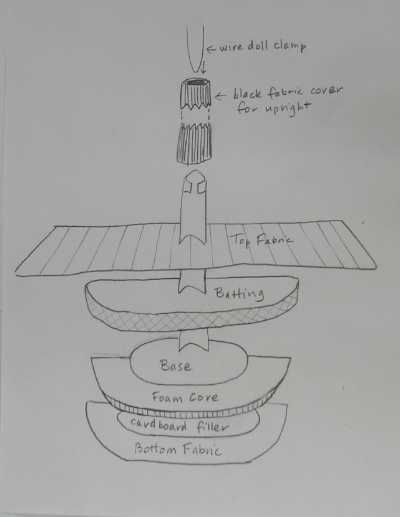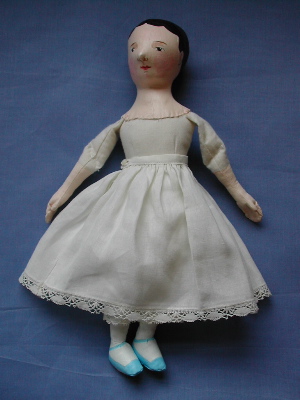This is an article I wrote for our doll club’s newsletter.
How I Make My Doll Bases
by Mimi Kirchner
I make dolls that do not stand on their own and are not posed. They just stand around and hopefully look pretty! When I send them out to a show, they need a stand for display, and I learned early on that the white stands that are available at the local Arts and Crafts store would not cut it. I have figured out that I can still buy my “cheapo†doll stands- I just have to dress them up.
Materials needed for doll stand project-
-1 commercially available doll stand in a size that will hold your doll. (illus. 1)
-a piece of foam core board- approx. 12†x 12†will probably be enough.
* note- I get free foam core and matt board scraps by asking at frame shops.
Tacky-Glue (or your favorite thick glue)
Fabric for top of stand- see ideas at the end
fabric for bottom of stand- “
decorative edging (optional)- “
Quilt batting- (optional)
cardboard pieces
black knit fabric- approx. 2†x 12†( may have to be bigger depending on the size of your doll and how much of the stand will show)
Clamps- I use clothes pins, bull dog clamps from Staples, hair clips and spring clamps, depending on the job.
1. and 2.

Planning
1. Set your doll on the stand.
2. Consider your fabrics by placing choices under the doll’s feet. It is important that the fabric does not blend in with the feet and make them disappear!
In choosing a material, think about where you imagine your doll to be- in the kitchen?- tiles or linoleum, in the study- how about an oriental rug pattern. School- tile or cork(?), playground- grass or leaves. At the ball- parquet. And, how will the color and textures you use enhance your doll.
3. How big do you want your base?-
-The most important thing is that the doll is stable on it’s base- not at all tippy- even if tippy is the “look†you want.
-The base can define a bottom for an imaginary case around the doll. Think about how the doll would look if the walls actually were there. crowded and cramped?- too small. lost?- too big. (illus. 2)
-a tall, thin adult doll will look better on a smaller base then a shorter rounder child doll.
-The doll’s base is equivalent to a painting’s frame- it defines the place where the piece exists. Make sure your doll has a big enough space.
Some shape ideas-
formal look-
square with rounded corners
flat back, round front
less formal look-
oval
rectangle with rounded corners
Assembling
1. Remove the wire doll clamp from the stand and set aside. (there are other doll stands that have a removable upright shaft – take that off also)
2. Make a paper pattern to cut the hole in the fabric for the upright in your doll stand. (illus. 4)
-Lay a piece of paper under the base and trace and then cut out the circle.
-Lay the paper circle on top of the base. Fold back where the paper touches the upright. -Mark where the metal touches your paper. (A.)
-Move your paper to the back of the base and measure from the edge of the base to the edge of the upright. (B.)
-Your pattern should look like this (C.)-
Try to approximate the shape of the bottom of the upright as you connect the dots. (D.) Cut along your drawn line and try it onto the base. It should fit very closely. If it doesn’t, scotch tape over your cut and try again.
-Put the paper aside for now.
4. and 5.

3.Cut out your foam core to desired size and shape. To make nice curves, use things you have around the house- bowls and plates, for instance.
*how I make an oval-
traced 2 circles and straight lines to attach them.
4. Put a ring of glue around the bottom edge of your doll stand and place it on the foam core. In most cases your doll stand is placed so that it touches the middle of the back edge. (illus. 5)
5. (optional) Cut out a piece of quilt batting- I use a 1†thick poly- the same size as the foam core. I like the cushiony look this gives. It hides all evidence of the original base, especially if you are using a light material or paper. Cut a whole for the upright and slip it on.
6. Cut your top material so that you have AT LEAST 1†(2†is safer) larger then your foam core.
-Keeping in mind your extra fabric allowance, put your paper pattern onto the fabric and mark where your U-shaped cut will be. Do NOT cut in from the edge! Cut ONLY the U-shape. The less you cut, the neater the base will be. It is better to stretch your cut over the upright or to go back and make another clip then to cut it too big. Slip your top material over the upright and into place.
you now have-
________ top material
______ batting
___ base
______ foam core
7. Turn the base over and lay on the edge of a table so that the upright is pointing down, and the main part of the project is supported on the table.
You will now be gluing the fabric onto the bottom of the foam core. Put a line of glue around the edge about 1/2†in from the edge.
First fold down the largest areas you can- the straight line areas, if there are any. Then carefully clip and stick down the curved areas. Clamp as you go along. You will have to clip a lot of the fabric to make smooth curves. It is best if the fabric does not overlap because you will end up with a lumpy bottom on your base.
It is a good idea to protect the top fabric when you clamp- put something stiff between the fabric and the clamp- like a popsicle stick or stiff cardboard pieces.
Let everything dry before the next step.
*note- at some point you may have to put a dot of glue at the base of the upright if your cut-out flap just won’t stay down.
8. If you are going to put piping on the edge, glue it on now.
I often put a piece of cardboard into the center space created by gluing down the top fabric. This evens out the bottom- no dip in the center.
9. Choose your bottom material and cut to the size of your base. (no matter how carefully I try to do this step, I always end up having to do a little trimming after it is glued and dried- so be warned!) It is most important that the edges are securely glued. I put a line of glue about 1/4†in from the edge and then spread it toward the edge with a scrap of cardboard. Place your base onto the fabric. Fiddle until it is just right and then weight the whole thing with some heavy books until it is dry.
10. finishing the edge- I like to cover the place where the top fabric meets the bottom fabric. I have used upholstery edgings and piping, ribbon and artificial flowers, flower petals, and leaves. Glue them on and pin in place until they are dry.
11. Take the piece of black knit fabric and sew up the long edge to form a tube. Turn. Slip the tube over the upright piece.
12. Now, put it all together! Push the black fabric tube down toward the bottom of the upright and put the wire doll clamp back into place. Put your doll into it’s new “homeâ€. Adjust the height of the wire holder. When the doll is just where you want it, put some tape at the place where the wire goes into the upright. This will keep it from slipping around. Pull the black fabric sleeve back up to cover the upright. You are done!

Some material ideas for top fabrics-
-Upholstery fabrics
-artist canvas- you can paint it any way you like
-ultra-suede
-cork sheeting
-“grass†paper used for model railroad setups. If it is shedding like mine was, paint it with clear acrylic or modge-podge
-rice paper
-wood veneer
–doll house supply papers- can look like grass, wood, tile, carpet etc.!
Materials for bottom of base
-felt
-cork sheeting
-ultra suede
-matt board
finish edging
-ribbon- velvet looks very nice
upholstery edging
-any piping
-fabric or silk flowers, leaves or petals





